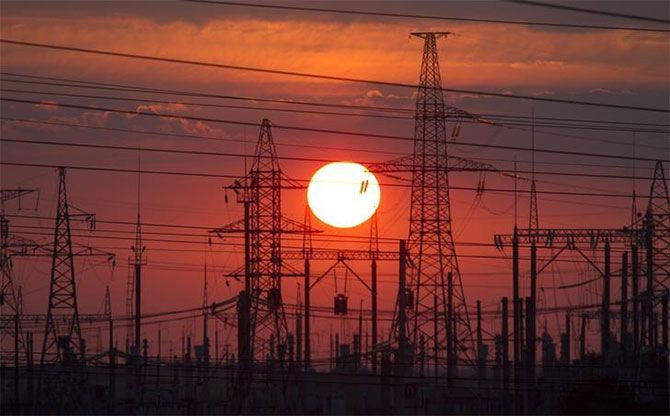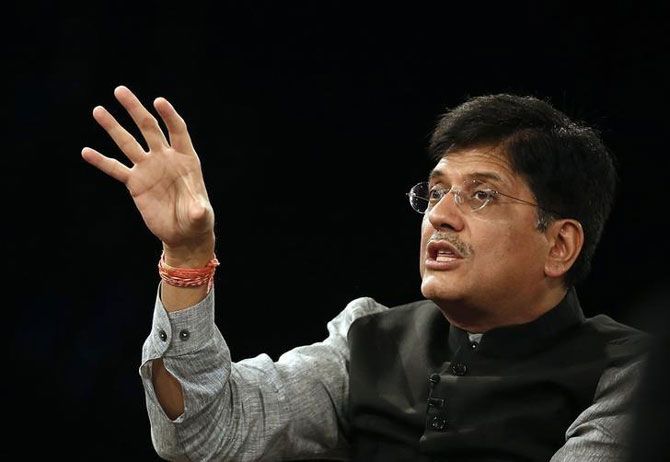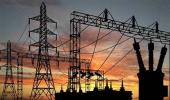‘I do not see any stress coming in the near future even if demand grows in double-digit.’
‘I am hoping by March next year, we should cross 20,000 Mw, which was a target for 2022.’

Piyush Goyal, Union minister for power, coal, renewable energy and mines, had inherited debt-laden power distribution companies and stalled projects when he took charge in May 2014.
The scenario has changed dramatically since then.
 In an interview with Shreya Jai and Jyoti Mukul, Goyal, left, talks about the government’s manufacturing push and other key issues.
In an interview with Shreya Jai and Jyoti Mukul, Goyal, left, talks about the government’s manufacturing push and other key issues.
In conventional power, are we heading for a down cycle as investment is not coming? How will demand increase be met?
We are currently at plant load factors where we can extend power generation by 50 per cent at our coal-based plants, literally tomorrow.
In addition to that, there is 20,000 megawatts (Mw) which doesn’t have power purchase agreements (PPAs), and they (power generators) are occasionally selling it on exchange. That capacity can be added on.
Then, there is 70,000 Mw which is at different stages of implementation and will start coming up from the next year to 2022-23.
We have sufficient capacity coming up. I do not see any stress coming in the near future even if demand grows in double-digit.
Having said that, we recognise that we have to keep expanding our capacity.
I have two plans for that.
One, wherever we have more than 25-year-old plants, we will replace them with supercritical capacity, and there will naturally be an increase in capacity. Coal is sufficiently available.
Then, UMPPs (ultra mega power projects) will start coming in as we finalise documents. We have made a robust bankable document.
I am glad we didn’t bid earlier because with interest rates falling and equipment cost coming down, we can get attractive pricing. It may not be as low as those (in earlier times) because some of them were not viable.
Today the nation will not pay a very high price for power. Nobody will pay more than Rs 3-3.5 (a unit) for power.
How do you plan to bring transparency in procurement?
I am going to make merit order of dispatch (the order in which distribution companies prioritise purchase of power) available through mobile applications.
Power sector is one of those where bad loan is a huge issue. After the new Ordinance on bank NPAs, how do you see a resolution in the sector?
In power, there are two types of problems.
One, there are projects which are established and can get completed but do not have PPAs. As demand picks up, we’ll see some of them picking up business.
There is another set of power plants where promoters themselves are truant, in which case both lenders and promoters will suffer consequences.
We cannot artificially create demand or force people to waste energy. On the contrary, we are promoting energy conservation.
Our (compound annual growth rate) growth has been 6.5 per cent in three years compared to 6.15 per cent in the last 10 years. This 6.5 per cent is after saving three per cent through LED (light-emitting diode).
If we did not focus on efficiency and LED, power demand would have grown 9-9.5 per cent. There has also been a growth in captive power generation.
Where do you see fresh demand for power coming?
Make in India efforts and the ease of doing business will create some demand, but who will come to India if they know we are perennially short in power or have to buy power at Rs 8-10?
I am encouraging states that after the goods and services tax (GST), there will not be any excise or any other duty concession. The only hope is to give land and power at concessional rates, besides (ensuring) ease of doing business.
Uttar Pradesh is working on it. We are hoping other states will follow to encourage new manufacturing and demand.
(States should) offer attractive power prices and fixed prices for 10-15 years. There should be innovative ways to manufacture.
In coal, the push is for domestic, but in solar it is import-driven. How do you plan to promote manufacturing in solar?
I have to run my programmes intelligently. If too many objectives gather, I will not be able to achieve anything.
The manufacturing capacity that came earlier was not viable because it was very small in scale. My first and foremost objective was to get solar ingrained in the Indian system and bring volumes into India.
The task was to bring economies of scale and bring down prices through transparency so that states are encouraged to buy. At Rs 3, solar power is cheap and there is security because it will cost the same for 25 years when coal power will be Rs 10-15.
Now, when I promote domestic manufacturing, the difference could be 20-25 paise which the country can afford. We will encourage solar wafer manufacturing in India. In modules, there is 6-7 Gw capacity and it is growing rapidly.
For solar cells, we will become self-sufficient in six to eight months. We need to push for wafers, and BHEL will set up a plant.
Now that we have seen bids going low without any viability gap funding, do you think it is time to do away with VGF or any such support to renewable energy and instead give subsidy to manufacturing?
I keep calibrating. I won’t be surprised if that happens.
Subsidising manufacturing, instead, is not a bad idea. We could look at things like tighter quality control, so that we get good quality equipment for our solar programme. You would have to be an approved supplier.
There will be a process to maintain tighter standards to maintain efficiency.
How will the next level of scaling up in solar and wind come?
I am hoping by March next year, we should cross 20,000 Mw, which was a target for 2022.
You talked about UMPPs coming back and a push to solar manufacturing. What is your message to private investors, across all your sectors?
This government’s focus is to ensure that whoever invests gets a clean and clear predictable regime. This will help encourage investment in this field.
For example, our guidelines for PPAs for solar power projects have been revised so well that it is a robust document that anybody in the world would be ready to invest. They feel safe and secure.
Secondly, the transparency we have brought in, it has made it an honest and corruption-free regime.
All of these things are helping the world want to come and invest in India -- Indian promoters, international companies. India is a nation where there is more than generation; there is transmission, distribution, technology upgradation, system development. All of these are bigger opportunities of investment in India.
Renewable energy thrust has been unprecedented. My sense is overall it will be a bright future for investment in this sector. All discoms would start making profits two years from now.
In transmission, what are your plans, especially when so much renewable is coming and it would need a balanced and robust grid?
We plan for 175 Gw and it is fully planned.
How would you now look at UDAY (Ujjwal Discom Assurance Yojana)?
Super success. Different states joined at different times. UP was the first one to join and then they did nothing. Now, the new government is acting on it.
Maharashtra, Gujarat, Karnataka, Haryana, Rajasthan and Tamil Nadu have benefitted hugely.
Those who worked hard under UDAY reaped benefits. It depends on the state.
I can take water to them but they will have to put in effort to drink it.
In the mining sector, what is your key focus area?
We are encouraging the states to bid mines faster now. We are just focusing on exploration.
I am also willing to handhold if the states want support but ultimately it’s a state activity, and revenue also goes to the state, like in the case of coal blocks.
We are a policy-making body, but we can help states do the auction. With MSTC etc, we will create enabling provisions.
For district mineral foundation (DMF), I have told states to create sustainable assets.
Jharkhand, for instance, has done a fantastic job. They received huge amount under DMF and they used it for safe drinking water for their people.












 © 2025
© 2025